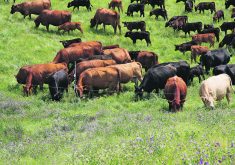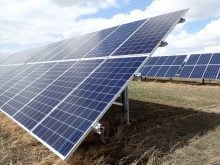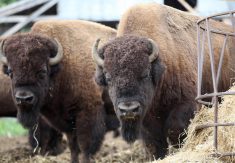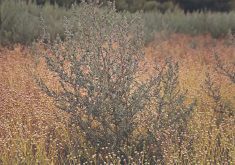Devil’s flowers
Sometimes we say we have entertained angels unaware. This summer I entertained devils unaware.
Whenever it was available I would buy from greenhouses the pretty plant angel’s trumpet, and plant it on the west side of the gazebo. The fine white blooms were a pleasure to see but it never seeded down.
I think it was in 1998 that I had to make several trips through a certain village hauling cattle from summer pasture for a sister. We were struck by what appeared to be a hedge of angel’s trumpet. How odd we thought. Upon enquiry the householder said it seeded down every year. We thought no more about it, except to wonder once in a while.
Read Also

High prices see cow-calf producers rushing to incorporate
Farm accountants are reporting a steady stream of cow-calf producers rushing to get their operations incorporated ahead of selling their calves this fall.
This summer I saw what appeared to be angel’s trumpet growing among roses on the south side of the gazebo. Again, how odd. I left them but began to view them with suspicion.
The flowers were smaller; the leaves more jagged, the growth tall and sprawling. I decided to pull them out. Some had thick stems; they had to be cut as pulling was impossible.
I cut off the vicious spiny seed pods and dropped them into a sturdy potting soil plastic bag, and wrapped the green plants in plastic to rot. There were possibly 24 plants and three to four gallons worth of pods, likely more.
It turned out I made the decision the same week the article appeared in The Producer about devil’s trumpet, Datura stramonium, known in the U.S. long ago as Jimson weed.
I’d read about Jimson weed years ago. Oh, it wasn’t here. I’d also read about Johne’s disease in cattle in the southern U.S. Oh, it wasn’t here. Like all weeds, all cattle diseases we have become host and hostess to them all. Everything is here, it seems.
I could write pages and pages about the weeds introduced here and how I have fought them. I could almost say who or what kindly brought them here.
Oil companies are notorious for spreading weeds. Many times I have stepped off various horses to pull various weeds such as scentless chamomile on oil well access roads in neighbour’s fields. It’s even worse when oil well roads are in virgin land.
Don’t forget the chickweed, the cleavers, the foxtail, which have come in purchases of registered seed, up to 160 acres worth.
I’ve seen a large patch of toadflax right at the gate of a so-called steward of land. Are today’s landowners incapable of hand spraying or of bending their backs to pull the first of some invasive weeds?
If I live long enough I might get the upper hand, in the most bee and bird friendly methods possible.
That hedge of what could only have been devil’s trumpet in that village: long gone.
But where did it come from? Where did the plants come from which were growing among the roses here?
Christine Pike
Change needed
I feel our province needs to have a long-term vision for the future as it concerns the environment and global warming. We cannot deny that climate change is upon us. When I was a kid in the 60s, we had four separate seasons. Now we just have warm or cold spells. Lately the climate is so messed up that current weather patterns are erratic to say the least.
Every day is different and we never know if we have to put on galoshes, runners or snow boots when we finally go outside in the morning. Government has to take the proverbial “bull by the horns” and create visionary policy that will help both current and future generations of Albertans and Canadians deal with the effects of climate change.
Let us take our lead from Brazil, where vast sections of the Amazon rain forest have been set aside from the ravages of development. My solution is the creation of Canada’s first dedicated Carbon Sink Provincial Park.
A legacy for future generations. A park consisting of one million acres where no drilling, no logging, no industrial activity would be allowed. A park which would provide limited access for fishing and hunting for both Alberta residents and Aboriginal peoples.
I challenge the current Alberta government to stand out from the rest of Canada and create the Alberta Legacy Carbon Sink Provincial Park.
Without setting aside forests for the future, how can we deal with the “destructive forces” of global warming and climate change?
Thomas Deak
Edmonton, Alta.














